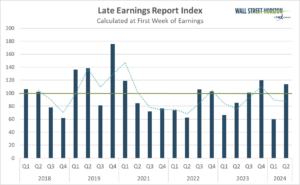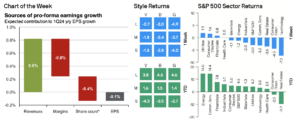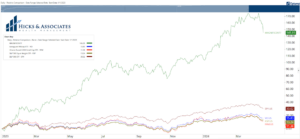Last month, I started a new series of articles I am going to write to highlight some of the episodes of our Excess Returns podcast that I have learned the most from and the biggest lessons I learned from them. In my initial article, I looked at our episode with Andrew Beer.
This week, I want to look at the episode we just released yesterday with Harley Bassman. Harley is one of the most knowledgeable people we have talked to on a variety of topics, including convexity, fixed income, and what is going on in the macroeconomy.
Here are the top three biggest lessons I took from the interview.
1 – Convexity Can Be an Investor’s Best Friend When Used Wisely
Positive convexity refers to the idea that some investment products can produce nonlinear outcomes on the upside. The way Harley explained it, if an investment can lose $1, but can gain $2, it exhibits positive convexity. But like anything in investing, that positive profile typically comes with a price in the form of paying more upfront to get it or losing money over time until the event that triggers the upside occurs.
The real power of convexity in my opinion comes in when an investor can invest in positive convexity products that have negative correlation with their core portfolios. These types of products can boost the overall return of a portfolio even if they have a much lower long-term return than the rest of the portfolio due to the rebalancing effect.
To illustrate how this works, think about an investor who holds 100% equities, but couples that with a small allocation to a tail risk strategy. If equities have a sharp drawdown like they did in 2020, that tail risk product can produce a very large positive return. If an investor takes advantage of that increase by using the gains to systematically buy more equities during the decline, the result is effectively a buy the dip strategy that acquires equities when they are down. This ability to produce returns when equities are at their worst and use the proceeds to reinvest in them can actually boost the returns for an equity portfolio even though most tail risk strategies on their own have low to negative long-term returns.
This type of approach is a complicated one and is something that many investors probably shouldn’t attempt, but Harley’s company Simplify has launched several ETFs that take advantage of convexity and can be an asset to investors and advisors who understand how to use them.
2 – Life is Much More than Investing
Since I make my living in the investing world, I sometimes tend to focus too much on it. But some of my favorite lessons I have learned from our podcast have come from discussions we have had that focused on topics outside of the investing world. Our conversation on parenting with Jim O’Shaughnessy early on in the history of the podcast comes to mind as one that led me to make tangible changes in my life.
We only covered it briefly in the beginning of this episode, but Harley’s Maven Mantra is another example of something that helped me to refocus on what is really important.
Here is the mantra from his website:
#1 and #3 in particular both resonated with me. In light of everything we are seeing in the world right now with things like FTX, it is important to keep mind that character needs to come first and everything else comes after that. It can be tempting to lose focus on that when we see people earning life changing returns, but when those returns aren’t backed by high character individuals, they won’t last.
And on #3, Harley shared the quote with us that the graveyards are filled with indispensable people. The idea that all of us will eventually meet the same ending and we should enjoy our life to the fullest while we are here really resonated with me.
3 – To Understand the Mortgage Market We Need to Understand What Goes on Behind the Scenes
Harley wrote an excellent article recently on mortgage-backed securities and what happens behind the scenes when a mortgage is created. The recent rapid rise in mortgage rates is something that I have been trying to better understand and that article and his explanation of it at the end of the podcast helped a lot with that.
Many investors use the 10-year treasury yield plus a spread as a guide for mortgage rates. The increase in rates this year has not just been a function of a rising 10-year, but also an increase in that spread. Harley walked us through the process of understanding why that spread has widened, and why it might come down going forward. Since housing drives such a big part of our economy, understanding the behind the scenes process that drives mortgage rates was really interesting for me.
—
Originally Posted November 30, 2022 – Three Lessons from Harley Bassman
Disclosure: Interactive Brokers
Information posted on IBKR Campus that is provided by third-parties does NOT constitute a recommendation that you should contract for the services of that third party. Third-party participants who contribute to IBKR Campus are independent of Interactive Brokers and Interactive Brokers does not make any representations or warranties concerning the services offered, their past or future performance, or the accuracy of the information provided by the third party. Past performance is no guarantee of future results.
This material is from Validea Capital Management and is being posted with its permission. The views expressed in this material are solely those of the author and/or Validea Capital Management and Interactive Brokers is not endorsing or recommending any investment or trading discussed in the material. This material is not and should not be construed as an offer to buy or sell any security. It should not be construed as research or investment advice or a recommendation to buy, sell or hold any security or commodity. This material does not and is not intended to take into account the particular financial conditions, investment objectives or requirements of individual customers. Before acting on this material, you should consider whether it is suitable for your particular circumstances and, as necessary, seek professional advice.
Disclosure: Alternative Investments
Alternative investments can be highly illiquid, are speculative and may not be suitable for all investors. Investing in Alternative investments is only intended for experienced and sophisticated investors who have a high risk tolerance. Investors should carefully review and consider potential risks before investing. Significant risks may include but are not limited to the loss of all or a portion of an investment due to leverage; lack of liquidity; volatility of returns; restrictions on transferring of interests in a fund; lower diversification; complex tax structures; reduced regulation and higher fees.



























